The threat to newspapers now appears from nearly every indicator. From 1950 through 1999, for instance, newspaper revenue grew seven percent a year. From 2000 through 2006, by contrast, it has grown by just 0.5%. Then in the first quarter of 2006, growth was even less: 0.35%.
And though online ad revenues continue to soar, they currently account for just five percent of all newspaper company revenue. In addition to sluggish ad growth, newspapers are challenged with circulation declines, a skeptical Wall Street, ownership changes — such as Knight Ridder’s recent sale of its 32 papers– and perhaps most notably, adapting to the world of online news.
In this, the third of our roundtables on the future of the news media, six experts from inside the newspaper industry discuss its future, its fate, and the changes it must make to survive. They are:
- Phil Meyer, Knight Chair in Journalism, School of Journalism and Mass Communication at the University of North Carolina;
- John Carroll, editor of the Los Angeles Times from 2000 to 2005;
- Rick Edmonds, Researcher and Writer for the Poynter Institute and co-author of the newspaper chapter for the State of the News Media Annual Report;
- Paul Ginocchio, Media Analyst for Deutsche Bank. In 2005, Paul won a “Best on the Street” stock pricing award from the Wall Street Journal.
- Lou Ureneck, Chairman of the Department of Journalism at Boston University. Before his academic career, Ureneck serves as the deputy managing editor for the Philadelphia Inquirer and spent 22 years at the Portland Press Herald.
- Rick Rodriguez, Executive Editor and Senior Vice President of The Sacramento Bee, and in 2005-2006, President of the American Society of Newspaper Editors.
1. How much confidence do you have that traditional mainstream media organizations will survive and thrive in the transition to the Internet?
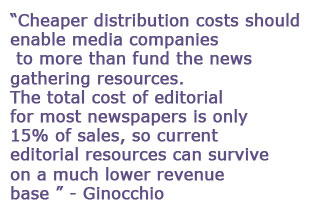
Paul Ginocchio: I have 100% confidence that the mainstream media organizations will survive. The toughest issue will be the transition period (from print to online, broadcast to broadband), but once the migration is over, cheaper distribution costs should enable media companies to more than fund the news gathering resources. The total cost of editorial for most newspapers is only 15% of sales, so current editorial resources can survive on a much lower revenue base.
Rick Edmonds: High. They have what democracy needs and it has market value too –original reporting and professional editing and packaging. I don’t see that emerging elsewhere as yet. But the economic transition will be long and tough.
Phil Meyer: Very little. The most successful applications of the Internet are likely to come from unexpected sources, as Craig Newmark has so clearly demonstrated. Traditional media organizations are risk averse and unwilling to invest enough in new experiments.
John Carroll: Some will survive and some will thrive, but there are real questions about the quantity and quality of original journalism that will be produced. We may well look back on the last forty years and view them as an anomaly, in which newspapers enjoyed such monopolistic conditions that they could afford to put an extraordinary number of reporters on the street. Our journalism may be leaner in the future – and possibly less principled and idealistic.
Rick Rodriguez: Much confidence. It will take strong leadership, vision, the willingness to take risks and some failures, but we’ll get there.
2. Looking specifically at print now. Do you think newspapers printed on paper are on a path to extinction? If not, what strategy is most likely to avoid extinction? (Investment, daring, urgency, calm, reinventing news delivery and audience or venturing into non-news online moneymakers?)
Phil Meyer: Extinction is unlikely. The successful local news product will probably be a hybrid with online providing most of the volume of content, and a smaller summary, perhaps less than daily, providing portability and the convenient scanning of print. The new magazine The Week is an interesting model.
Paul Ginocchio: Newspapers on paper may only be a 4-5 day a week event, with the other days online only. Printing facilities will be rationalized to third parties. Print subscriptions will rise in price so that the subscription revenue fully covers the paper, printing, distribution and administration surrounding the paper product – and most readers will get the product online. There will be a nominal online subscription fee and potentially, some papers will have a much higher fee if you want to get the news without advertising.
Rick Edmonds : I think the print newspaper is a survivor for at least 10 or 15 years — I hope to be alive and reading for at least that long and there are platoons of first wave baby boomers like me. Newspapers will keep having lots of cash to invest for some time to come. Proceeding “with all deliberate speed” makes sense and that is what newspapers seem to be doing. These big boats do not turn fast, but the industry needed to get a lot more urgent and has.
Rick Rodriguez: I think newspapers will be around for decades but will change. I think investigative journalism and other unique content are key to long-term survival. Newsrooms will have to run on multiple tracks – immediate postings through the web, daily paper, and paper and web longer term projects. I think other niche products that repackage the news and distribute it in various ways will continue to grow. So I don’t believe we’re on the path to extinction but on one that will require lots of change, including looking at ourselves as delivering news and information in lots of different ways.
Lou Ureneck: They are not headed to extinction, but certainly to contraction. I think that some people will always find newspapers on paper more convenient. But paper is expensive, so every square inch of it will be filled by only the highest and best uses, such as analytical journalism. Of course, stories will be shorter. Newsprint in the future will serve as the substrate for only the highest-end work or for readers who are wealthy enough, and willing, to pay for their preference for paper, I’m guessing. This trend will not be unlike the purpose that glossy paper now serves for some high-end magazines, such as the New Yorker. Routine content will find its way online. The migration of financial agate typifies what I think will become a growing trend.
John Carroll: Printed newspapers are declining, obviously. It’s possible that the printed paper could become a luxury item, sold at a high price, which would save the medium. Or – another hope – it’s possible that technology will preserve newspapers by allowing them to be printed out efficiently in the home, thus saving the costs of big presses, circulation departments, production departments, etc. Another technological fix: newspaper-like products that appear on tablet computers or on thin, lightweight computers that imitate the printed page. It’s not print, but it could be quite similar…
3. Do you think the economic model of the Internet has to shift from an advertising based model to something else for traditional journalism to continue to thrive? If so, do you have any thoughts on what that new model might be?
Rick Rodriguez: I think print advertising is in many categories still more effective than online ads. That isn’t necessarily true with classifieds, cars, travel and some others but many people just click through or block pop-ups and banners, even if they are creative. So the advertising model currently used isn’t going to work. But does that mean people would be willing to shift and pay for content when basically they’ve received it for free with an internet connection. It will be difficult as well.

Rick Edmonds : That’s unclear. Internet advertising has plenty of room to grow. Local search is at an infant stage and could be a goldmine. A mixture of free and paid premium content on the model of Times Select has potential too. The Bill Gates-Arthur Sulzberger presentation at ASNE persuaded me that Internet news will not look and read as it does now in another two or three years.
Paul Ginocchio: There will have to be some subscription revenues, but not as much as a print subscription. The print product will have to become a premium product to justify its cost and newspapers will outsource printing to third parties like Transcontinental (Canadian based printer). News gathering is only a small part of the total newspaper cost so it can survive on a pure ad model, as Phil Anschutz believes.
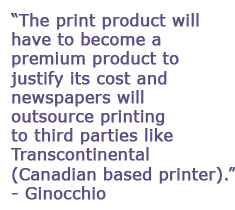
Lou Ureneck: Yes, I think future revenues will have to include higher proportion of fees from readers or users. As to a future model, this is the big question. We might be seeing the beginning of a return to some semblance, possibly, of private local ownership in places such as Philadelphia and St. Paul. Newspapers are profitable now and will be profitable in the future. The current crisis centers in large part on returns expected by investors who measure results against a range of businesses and whose only measure is financial.
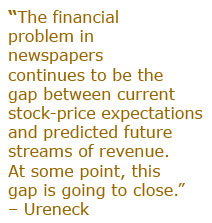
The financial problem in newspapers continues to be the gap between current stock-price expectations and predicted future streams of revenue. At some point, this gap is going to close, and it will close, I think, in the direction of permanently lower stock prices. That will settle some of the problem, though many people and institutions will have permanently loss significant stockholder “wealth.” But it’s a readjustment that tilts, I believe, in the direction of a healthier and more settled environment for journalism. (Click here more of Ureneck’s thoughts on newspapaper economics).
John Carroll: It would be good if newspapers and other providers of online content could (a) control the use of their content, and (b) charge for it. That would give them a greater degree of say in their own fates. With advertising rates set largely by others (Google, for example) and by extremely competitive markets, and with subscription revenue reduced nearly to zero, newspapers will be hard-pressed to sustain the large staffs that make them valuable. Giving our content away to all, even to our competitors, seems suicidal to me. Perhaps the resulting on-line ads will justify it, but I’m not yet convinced.
Phil Meyer: The “influence model” that I describe in The Vanishing Newspaper is certainly advertising based, and I think it could be applied to a community-based Internet publishing enterprise. We’ll soon know because it’s such an obvious strategy to try and the entry costs are low.
4. Now, looking at classified advertising, are papers doing everything they should to compete with Craigslist and others, including possibly, Google? If not, what should they be doing?
Phil Meyer: They should be trying more radical experiments and not leaving it to Newmark and Google to do all the innovating. But you can’t blame newspapers for being conservative. It’s a consequence of their easy-money history. It’s why I think the important innovations will come from outside. There are more Craig Newmarks out there.
Lou Ureneck: Newspapers either need to manage the decline of classified as a revenue source until it finally becomes free, or find a way to add value to the newspaper classified. Craiglist has changed the business forever. With its sorting functions, it’s as if the internet were designed for classifieds.
Paul Ginocchio: Newspapers are not promoting their websites enough and not aggressive enough in going out and getting new business – I believe they are still happy to wait for the classified customer to call them.
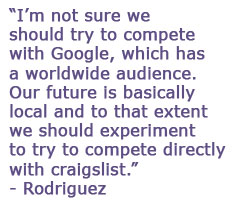
Rick Rodriguez: I’m not sure we should try to compete with Google, which has a worldwide audience. Our future is basically local and to that extent we should experiment to try to compete directly with craigslist. Are we doing enough as an industry? Obviously not.
John Carroll: The classified bonanza is over. It’s going to be a tough, very competitive game from now on.
Rick Edmonds : Local search has enormous potential and newspapers are racing Google et al. to get there. No one has mixed the magic formula yet, though, and it’s not clear (to me anyhow) whether newspapers or the big tech companies have the strategic advantage.
5. Circulation, revenue and newsroom investment data suggest that the newspapers most threatened right now are the big-city metro papers. How serious do you see this threat and what does it portend for state and local news? Would another news entity pick up that role or would citizens in end be left with little coverage of those institutions?
Paul Ginocchio: State and local news will still be covered, but not in the depth as it is today and it will have less prominence than in today’s paper. Some of the coverage will be from citizens helping out.
Rick Edmonds: I don’t yet see a case that blogs, citizen journalism and the like will emerge with a substitute for what big metros do best. However, like John Carroll, I am encouraged by recent indications that wealthy individuals, local group and/or not-for-profit entities will emerge, if necessary, to make sure communities have the degree of serious local news and public service they deserve.
Phil Meyer: More specialized media will pick up that role. The interesting problem will be defining their specialties. Much experimentation will take place, and the problem will be that not all of the experimenters will be journalists steeped in our public service tradition. The role of non-profits will become increasingly important as philanthropy takes on the watchdog task. An exciting, dangerous time lies ahead.
Lou Ureneck: It’s a very serious situation, and I worry that the work of the big metros will not be picked up by smaller newspapers or local television stations.
John Carroll: I see no sign of other, smaller papers extending their reach to cover these larger stories. If the big metros disappeared, perhaps some would come forward.
6. What, if anything, will it take for newspapers to get more young people to become regular readers, either online or on paper?
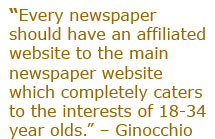
Paul Ginocchio: Hire more young people and cover the news they care about, not just what the editors and journalists want to cover – even if it is soft news. Every newspaper should have an affiliated website to the main newspaper website which completely caters to the interests of 18-34 year olds with a completely different set of values on what news is important.
[of Sacramento, CA]
Rick Edmonds: Doom and gloom studies notwithstanding, I think a reasonable percentage of young adults are interested in news (and even newspapers) and that more will be as they age. Chasing those who are basically uninterested or non-readers has always seemed a fruitless exercise. Of course newspapers should be adaptive but they equally need some confidence in the importance and utility of what they do. Realistically, the audience may grow bolder, narrower, more educated and more elite. If so, so be it.
Phil Meyer: That would require a cultural change, but it’s not impossible. If and when the international situation deteriorates to where we have to bring back the military draft, that alone might do it. More civics instruction in high schools, as David Mindich has suggested, would help. Whatever pulls young people’s attention away from popular culture and points them toward the real world could help newspapers – and society.
John Carroll: There is no single fix. At a fundamental level, we need to cover basic news that young people want, such as high school sports. I’m skeptical that we can compete seriously with other, flashier, less ethical outfits that provide gossip and entertainment coverage. More dauntingly, we need to provide news in forms that are appealing to young people, which may require insights and skills we don’t have at the moment.
7. If you could recommend one thing the newspaper industry would do differently what would that be?

John Carroll: The forty-year marriage of journalism and the modern corporation has failed. At the very time newspapers need enlightened stewardship, they are being actively harmed by their owners. Newspapers need a different form of ownership, one that values journalism, believes in public service and is unwilling – as a matter of principle and of long-term business strategy — to strangle newspapers for their short-term cash. Profit margins merely equal to the average among Fortune 500 companies would be a good start. That would allow newspapers to breathe again, to reverse their circulation losses, and to invest seriously in the online future.
Paul Ginocchio: Get a new ad salesforce, one that knows how to make cold calls and one that has no history of entitlement.
Lou Ureneck: Be bolder in their coverage of news. Seek truth over balance.
Rick Edmonds: Clarify to Wall Street that the news core must be kept strong, even at the expense of profit margins and earnings for a period of years because investments and experimentation in new media is essential too.
Phil Meyer: Transfer routine content to online, starting with the stock pages. Use the savings to invest in higher quality and more specialized content. Invest in radical experiments to find the right combination of newsprint and online distribution…





